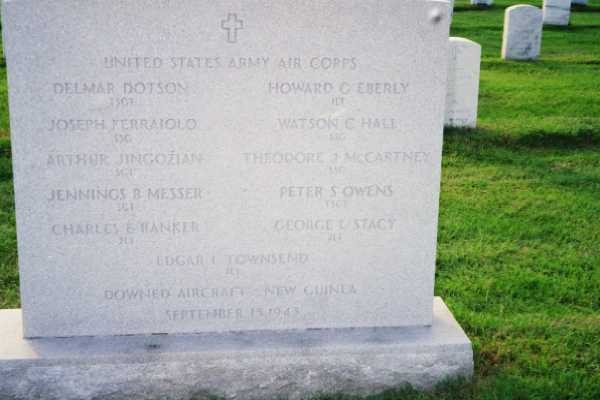From a press report: December 6, 1998
Fifty-five years after his death, Carrie Lee Nelson will bury her big brother Friday.
With the full military honors America accords its heroes, Techinal Sergeant Delmar Dotson will be laid to rest with other members of his bomber crew at Arlington National Cemetery.
For Wisconsin’s former first lady, it will close 52 years of not knowing and three years of waiting for military forensics experts to identify her brother’s remains.
He was 27 years old and a flight engineer on a B-17 Flying Fortress during World War II. It crashed during a storm on New Guinea on September 15, 1943, and was listed as missing until local people found it three years ago.
Carrie Lee, 75, the wife of the former Wisconsin governor and senator Gaylord Nelson, has a reputation for toughness. But when military authorities notified her of the find, she was overwhelmed and burst into tears.
Now, after three years of painstaking identification efforts, including an anthropological dig at the crash site and a DNA match of her blood with a leg bone found there, the Army is ready to close this chapter in the history of the 43rd Bomb Group.
For Carrie Lee Nelson, the word came with a visit to her home in Kensington, Maryland, by two Army representatives. They brought with them a fat book titled “Individual Deceased Personnel File.”
It was crammed with records and photographs — of bones, teeth, dog tags, buttons, watches, rings, eyeglasses, airplane parts and other artifacts found at the crash scene.
“It was just mind-boggling,” Nelson said. “I was absolutely fascinated but still overwhelmed that they would do all this after all these years.”
She did not know her brother well. He was seven years older, and they were two of 10 children.
The family lived in Wise County, Virginia. Her father was active in the county’s Masonic Lodge. After he died when she was 3, her mother no longer could support the family, and she and three of her brothers, at different times, were sent to live in the Masonic Home in Richmond. Nelson recalled one incident when Delmar rescued her. She was 7, sitting at a table in the home’s cafeteria with a matron hovering over her and ordering her to clean her plate after a meal.
“It was cold spinach or something,” she recalled. “Every other child had left. She told me I couldn’t leave until I ate it. It made me sick. I was ready to vomit.”
Delmar, then 14, walked in and saw what was going on. He plucked the food off the plate, tossed it across the table onto another plate and said, “Now it’s gone.” The matron said nothing. Carrie Lee got up and walked out with her brother.
Nelson, who is the last survivor among all her siblings, has few other memories of Delmar. But she has a copy of his birth certificate and photographs of him in uniform.
Dotson joined the Army Air Corps in Richmond in 1937. He went to flight school but did not qualify as a pilot, then left the service and became a trumpet and ukulele player in a band. When World War II started, he re-enlisted.
Nelson, after graduating from high school, went to nursing school and in 1945 joined the Army Nurse Corps as a second lieutenant.
She met Gaylord Nelson that same year on a blind date at Fort Indiantown Gap, Pennsylvania, where they both were stationed. Coincidentally, they were both later assigned to Okinawa, Japan, where Gaylord Nelson was a captain.
They resumed their romance and, after leaving the service and moving to Madison, they were married on November 15, 1947.
Gaylord Nelson, now 82, went into politics, served as governor from 1959 to 1963 and later served three terms in the U.S. Senate. Since his defeat in 1980 he has served as counselor to the Wilderness Society.
Besides Dotson, there were 10 men in the crew of the four-engine Flying Fortress when it went down. Nelson said that since the wreckage was found, she had been in touch with some of the other survivors, including a sister of the pilot, who lives in California.
Friday’s ceremonies will start at 9 a.m. with a combined Catholic-Protestant service in the chapel at Fort Myer, adjacent to Arlington.
The caskets — survivors had a choice of metal or wood — will already be in position at the grave sites in Section 60. Another casket with commingled remains will be transported from the chapel to the cemetery on a horse-drawn caisson.
A bugler will play taps, and riflemen will fire three volleys into the air. Along with the other survivors, Nelson will receive a folded flag, hers from her brother’s coffin.
At this stage, she says, there’s an odd feeling of emptiness.
“It’s hard even to know what to say,” she said. “You put something to bed in your mind, and then it reappears and reawakens the long ago in your life.”
Michael Robert Patterson was born in Arlington and is the son of a former officer of the US Army. So it was no wonder that sooner or later his interests drew him to American history and especially to American military history. Many of his articles can be found on renowned portals like the New York Times, Washingtonpost or Wikipedia.
Reviewed by: Michael Howard

